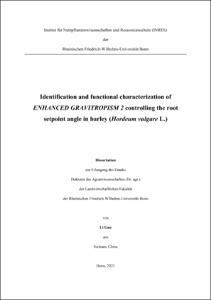Guo, Li: Identification and functional characterization of ENHANCED GRAVITROPISM 2 controlling the root setpoint angle in barley (Hordeum vulgare L.). - Bonn, 2023. - Dissertation, Rheinische Friedrich-Wilhelms-Universität Bonn.
Online-Ausgabe in bonndoc: https://nbn-resolving.org/urn:nbn:de:hbz:5-70203
Online-Ausgabe in bonndoc: https://nbn-resolving.org/urn:nbn:de:hbz:5-70203
@phdthesis{handle:20.500.11811/10693,
urn: https://nbn-resolving.org/urn:nbn:de:hbz:5-70203,
author = {{Li Guo}},
title = {Identification and functional characterization of ENHANCED GRAVITROPISM 2 controlling the root setpoint angle in barley (Hordeum vulgare L.)},
school = {Rheinische Friedrich-Wilhelms-Universität Bonn},
year = 2023,
month = mar,
note = {Root gravitropism allows plant roots to penetrate deep into the soil and is one of the main factors determining the root setpoint angle. Understanding the molecular mechanisms underlying the root setpoint angle of crop species can help to reshape root system architecture and to improve adaptation to changing environmental conditions.
The enhanced root gravitropism 2 (egt2) mutant was identified in a sodium azide-mutagenized barley population. The mutant shows a steeper root system compared with wild type due to the narrower growth angle of the seminal and lateral roots. Gravistimulation assays showed that the egt2 mutant responded faster and stronger to gravity compared to wild type plants. The EGT2 gene was mapped and cloned by a combination of bulked-segregant analysis and whole genome sequencing. The candidate gene, which encodes a sterile alpha motif containing protein, was validated by a novel CRISPR/Cas9 mutant allele. Mutations of the two EGT2 orthologs in tetraploid durum wheat resulted in a similar hypergravitropic phenotype of the wheat root system as observed in barley, suggesting that the function of EGT2 is evolutionarily conserved.
Root zone-specific transcriptome analyses of gravistimulated wild type roots in a time-course experiment demonstrated that the largest transcriptome changes in response to gravistimulation occurred in the elongation zone, the zone where root gravitropic bending occurs. By comparing egt2 and wild type before and after gravistimulation, we demonstrated that 33% of graviregulated genes in the elongation zone were also regulated by EGT2. This suggests that EGT2 plays a key role in controlling the molecular network associated with gravitropic bending.
A number of interaction candidates of EGT2 were identified by yeast-two-hybrid screening. Validation of selected proteins encoded by gravity and EGT2-regulated genes by bimolecular fluorescence complementation identified three direct interaction partners of EGT2 that might be involved in cell wall organization and flavonoid metabolism.
In summary, in this study we cloned and characterized EGT2, an evolutionarily conserved regulator of root setpoint angle in barley and demonstrated a substantial role of EGT2 in controlling the molecular networks underlying root gravitropic bending in response to gravistimulation.},
url = {https://hdl.handle.net/20.500.11811/10693}
}
urn: https://nbn-resolving.org/urn:nbn:de:hbz:5-70203,
author = {{Li Guo}},
title = {Identification and functional characterization of ENHANCED GRAVITROPISM 2 controlling the root setpoint angle in barley (Hordeum vulgare L.)},
school = {Rheinische Friedrich-Wilhelms-Universität Bonn},
year = 2023,
month = mar,
note = {Root gravitropism allows plant roots to penetrate deep into the soil and is one of the main factors determining the root setpoint angle. Understanding the molecular mechanisms underlying the root setpoint angle of crop species can help to reshape root system architecture and to improve adaptation to changing environmental conditions.
The enhanced root gravitropism 2 (egt2) mutant was identified in a sodium azide-mutagenized barley population. The mutant shows a steeper root system compared with wild type due to the narrower growth angle of the seminal and lateral roots. Gravistimulation assays showed that the egt2 mutant responded faster and stronger to gravity compared to wild type plants. The EGT2 gene was mapped and cloned by a combination of bulked-segregant analysis and whole genome sequencing. The candidate gene, which encodes a sterile alpha motif containing protein, was validated by a novel CRISPR/Cas9 mutant allele. Mutations of the two EGT2 orthologs in tetraploid durum wheat resulted in a similar hypergravitropic phenotype of the wheat root system as observed in barley, suggesting that the function of EGT2 is evolutionarily conserved.
Root zone-specific transcriptome analyses of gravistimulated wild type roots in a time-course experiment demonstrated that the largest transcriptome changes in response to gravistimulation occurred in the elongation zone, the zone where root gravitropic bending occurs. By comparing egt2 and wild type before and after gravistimulation, we demonstrated that 33% of graviregulated genes in the elongation zone were also regulated by EGT2. This suggests that EGT2 plays a key role in controlling the molecular network associated with gravitropic bending.
A number of interaction candidates of EGT2 were identified by yeast-two-hybrid screening. Validation of selected proteins encoded by gravity and EGT2-regulated genes by bimolecular fluorescence complementation identified three direct interaction partners of EGT2 that might be involved in cell wall organization and flavonoid metabolism.
In summary, in this study we cloned and characterized EGT2, an evolutionarily conserved regulator of root setpoint angle in barley and demonstrated a substantial role of EGT2 in controlling the molecular networks underlying root gravitropic bending in response to gravistimulation.},
url = {https://hdl.handle.net/20.500.11811/10693}
}






